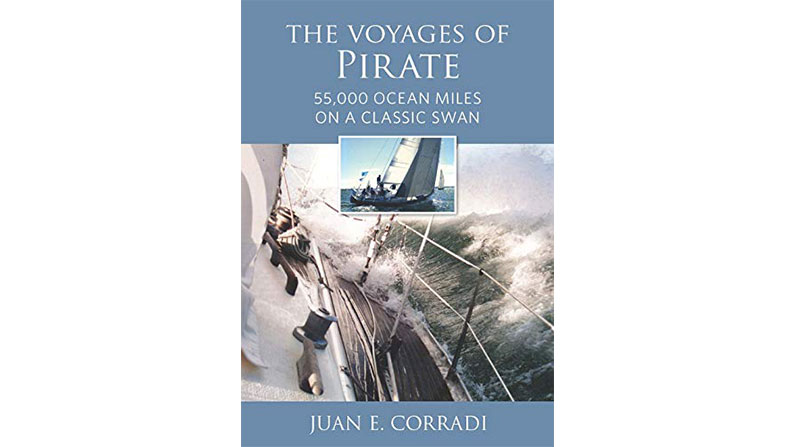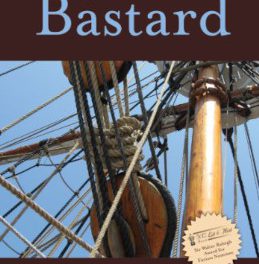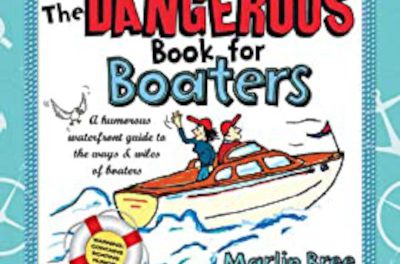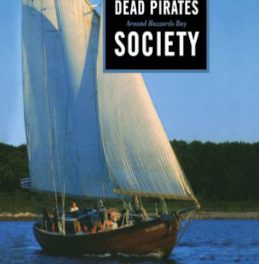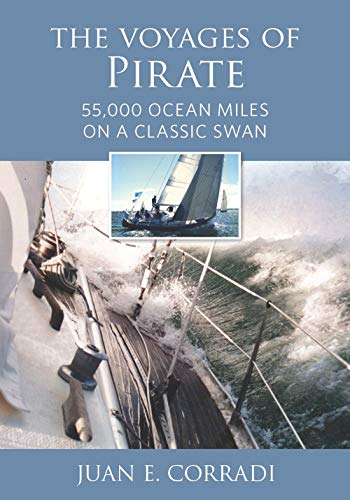 Pirate is an NYU professor’s telling of his adventures aboard Pirate, a 1974 Swan 38 he purchased in 1989, only four years after he learned to sail.
Pirate is an NYU professor’s telling of his adventures aboard Pirate, a 1974 Swan 38 he purchased in 1989, only four years after he learned to sail.
The number of miles that pass beneath a yacht’s keel and her surviving an infamous gale, may win her or her captain a reputation (and Pirate and Corradi rightfully deserve theirs), but there’s more to telling sea tales than miles and logs. Tristan Jones, who admittedly took his share of literary liberties, knew this well enough; Richard Maury, Bernard Moitessier, and old Josh Slocum, along with many others, understood it, too. Even E. B. White, author of the beloved little essay, “The Sea and the Wind that Blows,” knew that taking a fix at sea is one thing, a fix in life another. The days and the moments that make them meaningful are not so neatly calculated as positions on a chart.
Pirate doesn’t lack for details, the facts are there, but the book does often suffer from an absence of the right kind of detail. Take Corradi’s shipmates. They may be good and trusted friends, as well as great sailors, but they are not fully realized personalities as he presents them, nor as they sometimes present themselves in brief asides separate from the main narrative. One such recollection by Corradi’s wife, Christina, explains her primary reason for going to sea: “What truly intrigued me were the opportunities to understand the sublime…” But she gets no closer to the sublime than to declare it “something different than the beautiful, an emotional charge that intensifies experience,” or to realize in a storm that Hokusai’s “‘great wave’ print was not an exaggeration.” And so, the reader gets no closer to her. To declare that one has felt something may suffice in conversation, but readers deserve fuller testimony.
Instead of fully realized escapades, and the revelations they might artfully provide, Pirate too often provides instead the kind of thinly sketched accounts one might read in a press release or a newsletter. It’s not that other sailing writers, cruising authors mostly, don’t sometimes fall into a kind of basic reportage of places visited and things seen. The best among them often do. But they do so in greater detail and at a pace and in a style appropriate to the genre. They make use of anecdotes. They punctuate reportage with truly impressionable scenes. They don’t, one might say, write their way any faster than they go. Corradi’s book, on the other hand, often feels rushed, as if the racer in him has forgotten how to sail “full and by.”
The book, then, battles two headwinds. The first is a somewhat fractured structure punctuated by asides not written by the author, log entries, and work lists. These things would be more sensibly presented as appendices at the book’s end, or better yet, integrated into the narrative. The second is a mostly dispassionate tone. Corradi genuinely loves sailing; no one could sail as many miles offshore as he has who isn’t drawn almost beyond reason to sailing and the sea, but the book lacks the kind of language that might convey what John Masefield so passionately called “sea fever,” or that is evident in excerpts by the Portuguese poet Fernando Pessoa, Herman Melville, and others that Corradi includes. Entering “Viking waters,” Corradi tells us, “the more spectacular it got,” but the colors, scents, sounds, what it is that Corradi felt as he sailed “a sea as deeply blue as the Aegean”, or how Viking waters made a mark on him, or what mark they might make on us, we are never really told.
Remarkably, the author is not unaware of this tendency to skim over experiences that should be better sounded. Summing up five years of sailing in Nordic waters in one page, he confesses as much: “A summary cannot hope to provide flavor—the sights and sounds, the touch and taste that we experienced in those extraordinary years of sailing—nor convey a sense of what we learned.” And then, as if to say, No matter, we are told in the next paragraph that Pirate has a “new engine, a superb Beta Marine 28 hp, and a new Autoprop propeller,” leading us to believe these things are somehow more essential, and should serve as adequate consolation for what we might really want to know.
Toward the close of Pirate, following Corradi’s final Baltic cruise on the heels of an extensive restoration of the boat under the guidance of her original builder, Nautor, at the Yxpila Yard in Finland in 2008, Corradi and his wife decide to sell her.
Corradi and his wife, meanwhile, upon returning to the States, find themselves “sailors…bereft.” Reflecting on what it means to call something “classic,” the couple goes “looking for romance in a new old boat.” Referencing The Compleat Cruiser, L. Francis Hereshoff’s leisurely meditation on the art of cruising, Corradi reminds us of Herreshoff’s belief that something “classic” is “‘compleat’.” Nothing is lacking or out of place, and in its presence we recognize a kind of nearly perfect marriage between form and function, an unarguable harmonic beauty that transcends individual or contemporary tastes, and connects us to enduring truths. So inspired, Corradi and his wife step back in time, as it were, and buy an old Concordia Yawl, another legendary design, named Westray. Built of wood and equipped with a two-burner alcohol stove and “Pullman berths,” she is a boat they are sure will provide them “peace and freedom, away from gadgets and easy comforts, relying mostly on the old arts of seamanship,” without forcing them to give up the kind of performance they’d come to expect from their Swan 38.
Unlike Corradi’s account of his time with Pirate, Herreshoff’s Compleat Cruiser takes its time; it doesn’t rush. It doesn’t get too far as the seagull flies from where it begins, and in it one has time to savor, in their completeness, the many small charms and mysteries that await a sailor on any day. Herreshoff, hardly a stranger to the quest for speed, reminds us that time is not finally measured by the clock, or passages by leagues logged.
Corradi has proved himself an ambitious sailor, but one wishes he were both less and more so as a writer. Less ambitious in that he had not tried to cover the whole of his life with Pirate in one book. More ambitious in that he had worked harder to discover a deeper story there. The Voyages of Pirate has value as a historical document attached to a storied boat, a famous designer, and an accomplished blue-water captain and his crews. It adds, along with several other titles mentioned by Corradi, to the growing collection of literature about Sparkman & Stephens and their boats, and about the Swan line. It tells us something of what it is like to sail through the fjords of Norway, the moody winds of the Mediterranean, and the steadfast Atlantic trades. Or to roll the dice in a very big way on a very long race. And win. For these reasons, the book will always have a place on some sailors’ shelves.
But I do not think it is destined to become a classic. There isn’t enough of the fullness of time, or the depth of experience, to speak to a wider audience, or to those readers—sailors or not—looking for the kind of magic E.B. White knew one needn’t cross oceans or seas to find, though it is found there, too.
The Voyages of Pirate: 55,000 ocean miles on a classic Swan, by Juan Corradi (Sea Point Books + Media, 2019; 223 pages)

